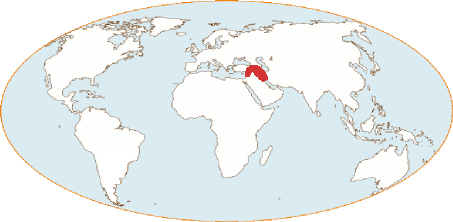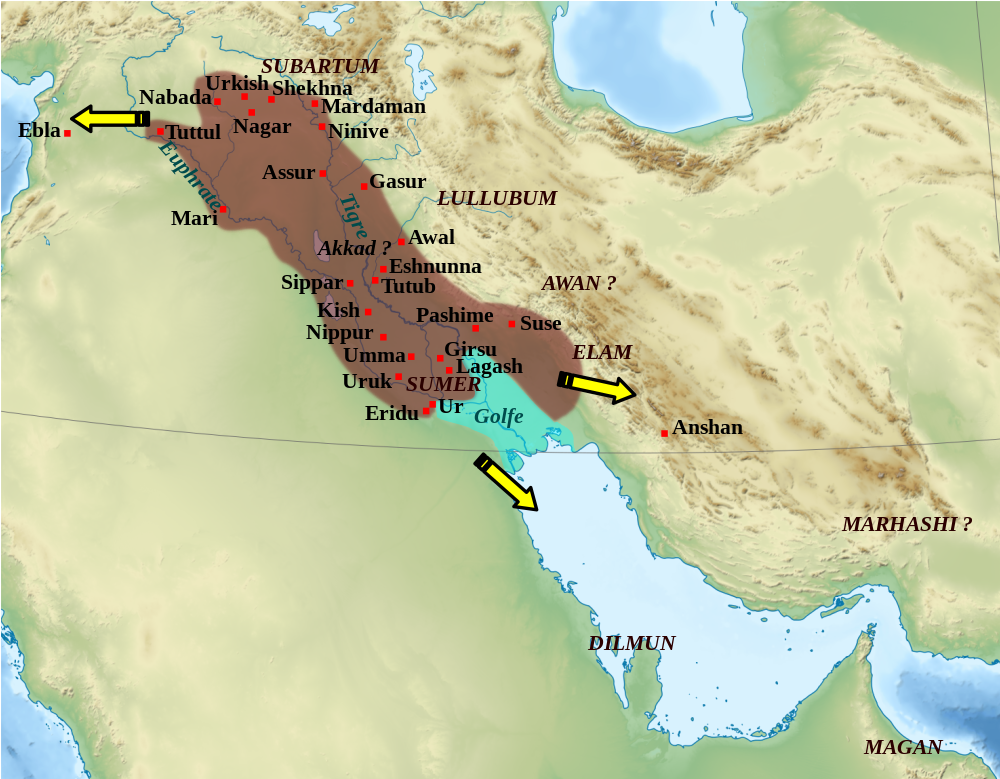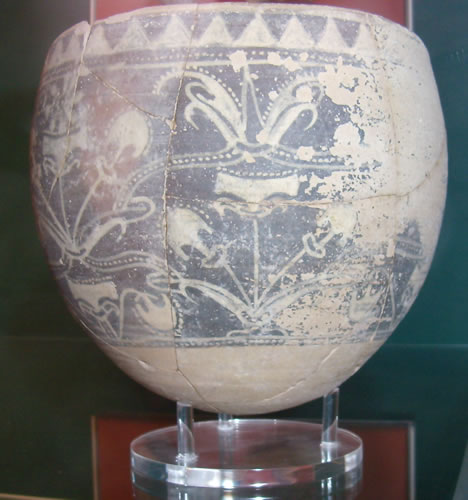Gasur and Nuzi towns on the eastern fringe of the Mesopotamian plain.
Along the eastern banks of the Tigris River, at the level of present-day Kirkuk, lies a buffer region between the Mesopotamian plain and the Zagros mountains. Its history, as ancient as it is tumultuous, has been revealed by the excavations carried out in the heart of Iraqi Kurdistan.
The site shelters in the middle of the 3rd millennium the city of Gasur, which became a millennium later Nuzi, city of the kingdom of Arrapha populated by a majority of Hurrites. The hurrite culture differs from the Sumerian-Akkadian background. Here lies the interest of the 6000 tablets discovered at Gasur-Nuzi. We see how the brewery developed there, under the influence of a specific cultural world (mountainous border of the Zagros), away from the powerful political centres that dominate the plains of the Euphrates and Tigris, but nevertheless remained within their sphere of influence.
Gasur, a provincial centre of the empire of Akkad (2350-2150 BC).
The foundation of the tell, now called Yorgan Tepe, dates back to the Vè millennium, the beginning of a permanent occupation for more than two millennia. The empire of Sargon, at its height, places the region under the control of a governor subject to the kings of Akkad. The site is then called Gasur, city and seat of a very fussy provincial administration. Gasur lies at the heart of a vast agricultural domain, dominated by members of the royal family, dignitaries and rich local landowners. Cultivation is entrusted to private individuals, simple workers organised in teams under the palace's iron rule or tenant farmers for their own account.
The system is based on a very strict centralised organisation: all grain movements (barley, wheat and emmer-wheat) are noted by the scribes. The productivity of the plots of land is calculated, the ratio of seeds needed, the volumes of grain harvested, winnowed and threshed, stored, the shares going to the palace or to the owners, the rations for men and animals, the production of flour, bread, malt, brewing loaves ( nig-ar-ra and BAPPIR) and finally the various types of beer[1].
Like the other imperial provinces, Gasur managed its cereal production as well as possible, according to the technical know-how and social system of the time. This province employed a large number of staff, which forced its administration to develop a vast system of redistribution in which bread and beer played, as elsewhere, a pivotal role. Surveyors, checkers, scribes, foremen, stewards, farmers, day labourers, craftsmen, guards and warehouse keepers: a cohort of servants whose food and fermented beverages are provided by the provincial authorities.
The accounting tablets have kept a few testimonials. The monthly grain rations are standardised: man = 60 l, woman = 40-30 l, male teenager = 30 l, female teenager = 30-20 l, baby = 10 l. This is the grid common to the whole empire. Beer bread (BAPPIR), malt and brewing loaves (nig-ar-ra) are made and delivered, all brewing ingredients. The beer is supplied to the dignitaries of Gasur as well as to certain categories of personnel and craftsmen[2].
The mention of maltsters reinforces the picture of a province organised around the circulation of cereal products. The beer brewing activity has a prominent place in this province. An excerpt from a letter from this period has come down to us. A manager is reproached for his silence on the guilty actions of a brewer : " Why did you discover that Bîtisa, the brewer, had sold the wheat for the bappir, and did you keep your mouth shut ?". The "wheat for the bappir" is here the raw wheat intended to make the brewing breads which we call BAPPIR.
Another anecdote. A king of Akkad stays in Gasur for an unidentified reason: inspection tour of the north of the empire, collection of the tribute of the provinces, military expedition against the northern city of Gasur built on the upper course of the Tigris? [3] The king's butler named Dada has barley, wheat-emmer, flours and loaves provided on the spot for the royal tour. When they arrive at Gasur, Dada and his entourage receive flour and beer-dida. Other officers staying in the town of Gasur receive allowances of barley, flour, semolina and beer. One of them, Ur-Gibil, is given kaš-ùs-sa beer to taste it. This mention of a beer taster in the royal entourage is unique. It is not known whether the practice is institutional or whether the king's journey to a hostile country justifies this safety against a possible poisoning through the beer.
The malting-brewing operations reflect the large cereal production of the region. The large agricultural estates provide the centralised grain stocks. Combined with the necessary maintenance of the productive staff and the processing of agricultural products, these estates ensure the reliability of the beer production. At the heart of a buffer region, the beer brewing at Gasur is managed a priori like that of the other provinces of the Akkadian empire.
Nuzi, on the eastern fringe of the kingdom of Mitanni (16th-14th centuries BC).
One millennium later, the documents-witnesses of the social life at Nuzi are much more astonishing. They plunge us into the core of a flourishing Hurrite culture, in a region close to the Iranian plateau populated by mountain nomads whose cultural values and history differ from those of the Mesopotamian urban civilisation.
Between the 16th and 14th centuries, Nuzi is part of the kingdom of Arrapha, vassal of the powerful king of Mitanni which dominates the vast territory from the Levant (Qadesh on the banks of the Orontes) to the foothills of the Zagros. The court settles in the city of Arrapha, a proximity that benefits Nuzi. In the centre of this later city rise the residence of the prince Šilwa-tešub and a double temple dedicated to the goddess Ištar and to Tešub, hurrite god of the Thunderstorm. Around them, the houses shelter rich families deriving their income from vast land estates or from trade. The poorest alienate their land, disguising under the cover of adoption contracts the sale of the family's land heritage, a transfer prohibited by the Hurrian's tradition.
We know the extreme example of a man who became the owner of a vast estate after being adopted by more than 120 different families. These legal fictions allowed him to gather a multitude of plots of land. Numerous family archives, mostly contracts, show the great concentration of wealth and its corollary, the use of a large number of domestic slaves. The management of the estates of the prince Šilwa-teššup, studied through long nominative lists of rationaries, relies on these slaves, bound to the house of the prince as service personnel or assigned to productive tasks (farm workers, potters, weavers, millers, ...).
Those forced into servitude by debt or extreme poverty to sell themselves to the richest are resigned to servitude. The kingdom also finds its slaves among the Lulleans, eastern mountaineers taken prisoner or who have come to be sold. This social misery is coupled with economic poverty. If the hierarchy of barley rations copied the Mesopotamian system (barême for adult male, female, adolescent, child), the given amounts of grains were halved!
In this context of extreme social inequality, the circulation of grain in its valued forms (malt and beer) only benefits certain categories: palace dignitaries, priests and wealthy families. The mentions of brewing ingredients or distributed beer are rarer on the accounting tablets, compared to other economic archives of that time. 41 litres of barley for the BAPPIR, 36 litres for malt are received by Tultukka, a steward[4]. These volumes remain small, compared to the hundreds of litres of barley recorded in the archives of Nuzi one millenium earlier. Gathered together with seed deliveries, these small quantities of BAPPIR and malt could be used to prepare a beer for an agrarian ritual, instead of a food beer.
For its own consumption, however, the palace allocates more impressive volumes, from 180 to 580 litres of barley per delivery to make the malt and the BAPPIR. One of this delivery records 5600 loaves of bread at once BAPPIR [5].As the local representative of the royal power, the palace of Nuzi provides its messengers with jars of beer, or grains for the beer brewing. A slip gives " 8 l of wheat for the ambassadors of Hanigalbat (kingdom of Mitanni) for beer and for bread "[6]. The sustenance of emissaries and foreigners is generally taken care of by the palace. It treats these distinguished guests well, especially when they represent the suzerain power of the Mitanni. They are supplied with wheat, instead of barley, to prepare a beer reputed to be of better quality.
The palace and the world of the wealthy city families are opposed to the living on agricultural estates, where conversion to barley and beer seems to be rare, no doubt reduced to collective and family celebrations. Among the craftmen of Nuzi are maltsters, brewers and cabaret keepers. The latter prove that beer is familiar to the population of the town and goes beyond the restricted circle of the palace[7]. The cabaret keeper works for well-off families, for example this family of scribes who write the deeds of a majority of households in Nuzi. Most of the inhabitants, slaves or miserable, have to live on less than ½ litre of barley per day. Not enough to hope for a bit of beer!
The Nuzi-city of the hurrite princedom offers a highly contrasted image. Its palace functions there according to the rules of redistribution established in other palaces and centres of power of the time. Consequently, the brewing crafts and techniques developed there, at Nuzi and Arrapha as elsewhere. However, most of the wealth of the kingdom and the means they provide (agricultural land, usurious loans on grain stocks, commercial exchanges) are concentrated in the hands of rich families. The economic circulation of grain is modified as a result. Whoever can monopolise the best grain lands - irrigated or irrigable - can also amass the grains and make a large part of the population dependent.
If the Hurrites all know beer, few of them can afford to drink it[8].
[1] Benjamin Foster 1987, People, Land and Produce at Sargonic Gasur, Studies on the Civilization and Culture of Nuzi and the Hurrians 2, 89. From the Sargonic period in Gasur, we have 230 tablets left.
[2] Ignace Gelb 1955, Old Akkadian Inscriptions in Chicago Natural History Museum, nos 9, 33, 46. The uncovered tablets are unfortunately too small a sample.
[3] Guiseppe Visicato 2001, The Journey of the Sargonic King, Compte rendu de la 45ème rencontre Assyriologique Internationale, 470-472.
[4] Wilhelm Gernot 1980, Das Archiv des Silwa-Teššup (Heft 2 et 3= Rationlisten I et II), n° 166.
[5] Harvard Semitic Series 13, 1942 : n°s 28, 301, 323, 347 et 412.
[6] Carlo Zaccagnini 1979, Les rapports entre Nuzi et Hanigalbat; The tallu measure of capacity at Nuzi, ASSUR 2, pp. 15 et 29.
[7] Leo Oppenheim 1939, Métiers et Professions à Nuzi, Revue d'Etudes Sémitiques, 61.
[8] In fact, we know little about the Mitanni and the Hurrian culture. Its capital or capitals (Washugani, Ta'idu) have not been discovered. As in any imperial political formation, the population was composite. One should not generalise to the whole of Mitanni what a few hundred tablets discovered in Nuzi suggest about the social role of beer and brewing techniques.






